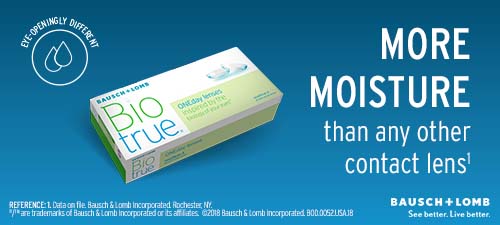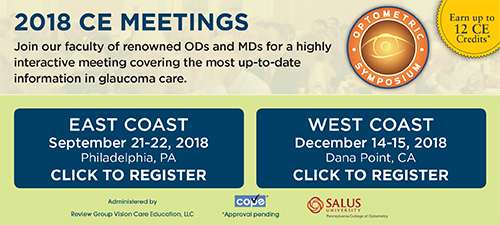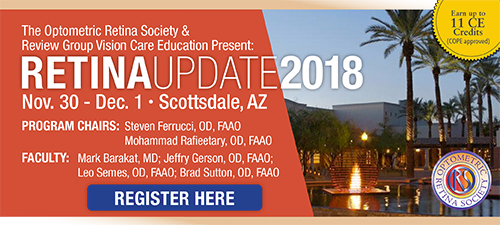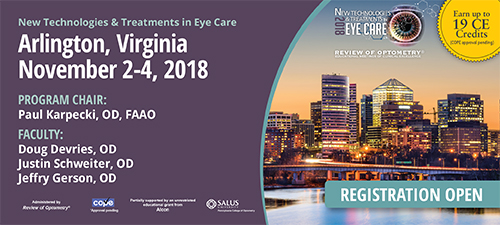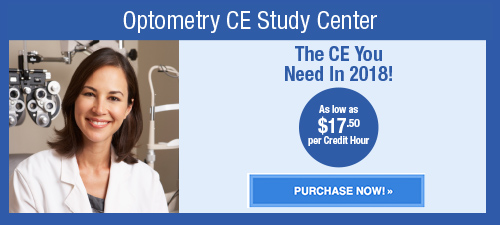
A
weekly e-journal by Art Epstein, OD, FAAO
Off the Cuff: Lumification
By now most of you have probably heard of Lumify. The recently introduced eye-whitening OTC drop by B+L works incredibly well for its labeled indication. What it does beyond that is surprising, if not potentially practice changing.
|
|||||
 |
||
| Impact of Dry Eye on Psychosomatic Symptoms and Quality of Life in a Healthy Youthful Clinical Sample | ||||
This study determined the impact of dry eye on quality of life, depression, anxiety and stress in a healthy youthful clinical sample. This was a clinic-based, cross-sectional study. Subjects were patients visiting the University of Cape Coast Eye Clinic for comprehensive eye examinations. The age range for recruitment into the study was 16 to 35 years. Eligible participants completed three questionnaires including the Ocular Surface Disease Index (OSDI); short version of the depression, anxiety, and stress scale (DASS-21); and dry eye quality of life score (DEQS) questionnaire. All eligible participants underwent clinical assessment including meibomian gland expressibility, corneal staining, tear breakup time and Schirmer 1 test. The Spearman correlation coefficient was used to determine the relationship between variables. Univariate and multivariate analyses of variance were used to determine the impact of the OSDI score on DASS-21 subscales scores and the dry eye quality of life scores. All 211 subjects who met the inclusion criteria were included in the analysis. The mean age for the entire sample was 21.6 ± 3 years with a range of (17 to 31) years. Spearman correlation coefficient showed a statistically significant association between OSDI and DEQS scores, and anxiety depression and stress scores. Spearman correlation coefficient showed no statistically significant association between clinical test results and quality of life scores, DASS-21 subscales scores, except anxiety subscale and meibomian gland expressibility scores. There were no statistically significant association between clinical test results and OSDI scores except for the tear breakup time. Using Pillai's trace in the multivariate analysis of variance (MANOVA), there was a significant effect of OSDI severity classification on depression, anxiety and stress subscales scores of the DASS-21, V=0.37, F(3, 207)=9.67. Furthermore, separate univariate analyses of variances on the outcome variables revealed a significant effect of OSDI severity classification on depression F(3, 207)=35.24, anxiety F(3, 207)=25.27 and stress F(3, 207)=13.08. The MANOVA was followed up with a discriminant analysis, which revealed three discriminant functions. When subjects were classified according to the OSDI grading of severity, there were a statistically significant difference between all levels of severity dry eye symptoms for the DEQSs (F[3, 207] = 63.9.3 p<0.001, η=0.48). The study showed that the severity of dry eye symptoms impacted on psychosomatic symptoms and quality of life. The study also revealed that the severity of dry eye symptoms impacted more on the depressive symptoms compared with other psychosomatic symptoms in this youthful clinical sample. |
||||
SOURCE: Asiedu K, Dzasimatu SK, Kyei S. Impact of dry eye on psychosomatic symptoms and quality of life in a healthy youthful clinical sample. Eye Contact Lens. 2018; Aug 20. [Epub ahead of print]. |
||||
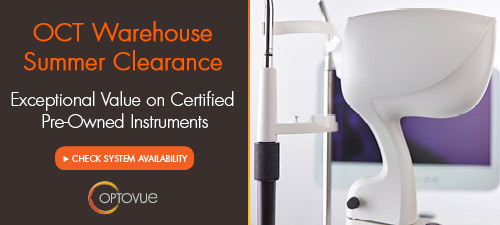 |
||
| Sjogren's Syndrome in Optometric Practices in North America | ||||
Records of Sjogren's syndrome (SS) patients were reviewed in six optometric sites to describe the presentation of dry eye in SS in optometric practices, to report on the methodology used in dry eye monitoring and to explore the level of corneal staining versus age and time of disease. A standardized abstraction tool was developed to collect data from the records including: health history, medications and symptoms, and signs of dry eye. The methods of testing symptoms and signs of dry eye were recorded. Variables were recorded at each site and collated at the University of Waterloo. The first visit after Jan. 1, 2000, was selected for description in this paper.
A total of 123 charts were included. The average time since diagnosis was 7.2 years ± 5.1 years. Symptoms of dryness were present in 110/123 = 89.4% of charts. Corneal fluorescein staining was present in 96/123 = 78% of charts. MGD was present in 52% of charts. There were significant differences in the protocols and grading systems used in these six sites. Corneal staining levels did not change with greater age or length of disease. These 123 SS patients presented with a large variation in their symptoms and signs. Symptoms of dryness and corneal fluorescein staining were the most commonly recorded presentations. There was a great deal of inconsistency in dry eye protocols among offices. Future prospective research with standardized testing will contribute to understanding the best dry eye protocols for SS patients. |
||||
SOURCE: Caffery B, Harthan J, Srinivasan S, et al. Sjogren's syndrome in optometric practices in North America. Cont Lens Anterior Eye. 2018; Aug 18. [Epub ahead of print]. |
||||
|
|||
| Delayed-onset Endophthalmitis Following Implantation of a XEN45 Glaucoma Device: a Case Report | ||||
A case of delayed-onset endophthalmitis ocurring after the implantation of a XEN45 device was presented. A 54-year-old male with bilateral elevated intraocular pressure (IOP) underwent placement of a XEN45 (Allergan) implant in his left eye. One month postoperatively, the patient required needling with adjuvant mitomycin C. Six months later, the IOP was well-controlled with treatment. Eight months after surgery, the patient presented to the emergency room and was diagnosed with left eye endophthalmitis. There was no history of trauma. The presence of erosions could not be thoroughly assessed due to significant conjunctival inflammation and friability, but a scleral necrosis patch was observed around the stent's subconjunctival pathway. The vitreous culture was positive for Streptococcus oralis. The blood culture was negative, and physical examination excluded any other endogenous cause. Given the poor clinical progression, persistent site of infection and no visual prognosis, an enucleation was performed. In the case presented, researchers hypothesized that a perforation of the conjunctiva was the most probable cause of the patient's endophthalmitis. They wrote that this case, together with previous case reports, highlighted the importance of periodic patient follow up after the procedure, as less invasive and seemingly safer, newer-generation implants for glaucoma surgery were not fully devoid of complications. |
||||
SOURCE: Colás-Tomás T, Pérez-Trigo S. Delayed-onset Endophthalmitis Following Implantation of a XEN45® Glaucoma Device: A Case Report. J Glaucoma. 2018; Aug 21. [Epub ahead of print]. |
||||
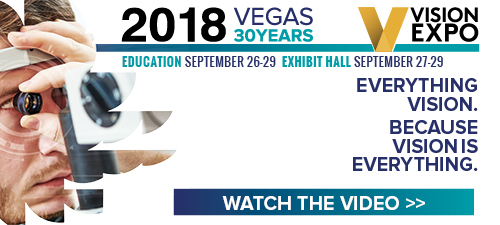 |
||
| News & Notes | |||||||||||||||||||||||||||||
B+L Names Gordon U.S. President; Vyzulta Available in 2.5mL Bottles |
|||||||||||||||||||||||||||||
| Allegro Appoints New CEO, Takes Risuteganib to Phase III, Allegro Ophthalmics’ board of directors named Vicken Karageozian, MD, as president and chief executive officer. Dr. Karageozian will prepare the company to enter Phase III clinical trials with lead compound risuteganib (Luminate) in diabetic macular edema and continue developing risuteganib for other retinal disease indications. Dr. Karageozian has more than 25 years’ experience building, leading and raising capital for companies in the ophthalmic pharmaceutical space. An ophthalmic surgeon by training and prior managing partner of Clarity Eye Group, Dr. Karageozian is the co-founder of three ophthalmic biotech companies and inventor/co-inventor of numerous ophthalmic products; he has 82 patents issued or pending. Read more. |
|||||||||||||||||||||||||||||
Envision Gathers Low Vision Care Experts for Annual Conference |
|||||||||||||||||||||||||||||
|
|||||||||||||||||||||||||||||
|
Optometric Physician™ (OP) newsletter is owned and published by Dr. Arthur Epstein. It is distributed by the Review Group, a Division of Jobson Medical Information LLC (JMI), 11 Campus Boulevard, Newtown Square, PA 19073. HOW TO ADVERTISE |


